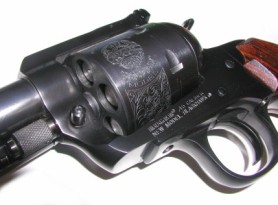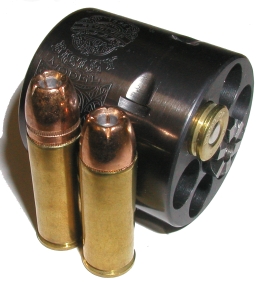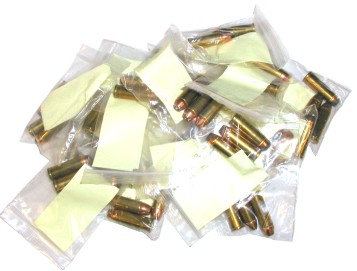
There is an increasing trend for handloaders to work to a firearm’s limit rather than a cartridge specification. The idea is that a cartridge pressure spec is scaled to the original firearm it was assigned, so when that cartridge is moved to a stronger action, it should be able to sustain higher pressure. This concept is clearly illustrated by the 45-70 Gov’t round. Loaded for the original trapdoor Springfield MAP is 28,000 PSI, but loaded for aRuger No. 1 that can routinely handle the 458 Lott’s 62,000 PSI, handloaders for the 45-70 push 50,000 PSI.
A quick look in most component manufacturers’ reloading manuals will show the same for the 45 Colt with sections dedicated to the Colt SAA and replicas and another section for Ruger Blackhawks and some lever action rifles. The 45 Colt has a MAP spec of 14,000 PSI. Handloading manuals usually have a Ruger section with a pressure ceiling somewhere between 25,000 – 32,000 PSI, the range mostly determined by the firearm types they include in the high pressure section. As an example, manuals that include Contenders tend to be more conservative with pressure.
Within the context of this article, brass plays virtually no roll in establishing pressure ceilings. Cartridge cases act as independent pressure vessels, they seal the chamber against the breech face. 8,000 PSI is all it takes to expand a cartridge case against the supporting steel pieces and from that point on it is the steel surrounding the case that is withstanding the pressure. The pressure it would take to flow brass out from pressure areas would be high enough to cause the steel parts to fail.
The Downside of Pushing Handloads
The greatest problem confronting handloaders who push cartridges is knowing what level of pressure is being generated. Increases in quantities of powder do not have a proportional result in pressure. Typically, the pressure curve sharpens as more powder is added, except where some heavily compressed loads, when used with magnum primers, result in lower pressure. The theory is that the primer drives the unburned charge against the bullet, forcing it forward and increasing the volume of space open to the now burning powder. Handloads that utilize powders designed for low pressure shotguns are frequently using a product that hasn’t been tested at high operating pressures, so burn characteristics are often unpredictable. Reading brass, examining primers, listening to rapport and measuring velocity offer pressure level clues, but none are precise enough to safely determine pressure levels.
Excessive pressure damage can be accumulative. Before metal parts burst they can be permanently stretched out of tolerance and weakened by excessive pressure; bowed chamber walls in some firearms is common. A handload may seem fine when fired a few times, then suddenly cause a barrel or receiver to burst. From a handloaders perspective, they may have survived a live fire test, but they don’t know if the load generated 40,000 PSI, 60,000 PSI or 79,000 PSI, or if the load is safe or a step toward future failure. The only safe harbor for the handloader is to obtain pressure checking equipment, or stay on the well documented path of mainstream handload data.
How did I get so smart?
Unfortunately I didn’t, however, I’ve learned to recognize credible sources when I see them. Some of the data that follows is drawn from mainstream handloading manuals, some from technical material published by knowledgeable gunsmiths like John Linebaugh, some from my own experimentation and pressure checking with an Oehler strain gauge setup and a test gun. In the absence of these inputs I never would have thought the Ruger could withstand these types of pressures. The cylinder wall thickness of a 45 Colt chambered Ruger is approximately .098″. To put this in context, the wall thickness of the Marlin Guide Gun is .346″, plus the wall thickness of the receiver of .116″, which puts .462″ or almost half an inch between the chamber and the outside world. Still, many people do not believe the Guide gun is designed to withstand 40,000 PSI.
There are many ways to determine the strength of a firearm. The first is theoretical based on calculation, mostly addressing the issues of breech face thrust, and longitudinal, radial and hoop stress, A second method is destructive testing; run it up till it blows up, but this approach is a little costly. Linebaugh’s article “The .45 Colt, dissolving the Myth, Discovering the Potential” is a good piece of information because it offers H.P. White Laboratory destructive test data and the author’s interpretation of results. Linebaugh concludes the Ruger Blackhawk is good for loads up to 32,000 CUP. Firearms similar in strength are: Blackhawk, Super Blackhawk, Bisley, large frame Vaquero, and Redhawk revolvers. Firearms that cannot withstand this type of pressure: small frame Vaqueros, Colt SAA and Colt reproductions.
The Bullet Lineup
One of the problems associated with handloading for a flexible cartridge is the number of possible component combinations. I tried to pick a good cross section of cast and jacketed bullets from light to heavy in weight.

| Manufacturer | Type | Listed Weight |
Scale Weight |
Length | Diameter | BHN* |
| Oregon Trail** | WNFPGC | 360 | 358 | .932 | .452 | 14.3 |
| Oregon Trail | FP | 300 | 300 | .797 | .452 | 20.9 |
| Oregon Trail | SWC | 255 | 252 | .691 | .452 | 15.4 |
| Sierra | JHC | 240 | 240 | .644 | .451 | – |
| Nosler | HP | 250 | 250 | .676 | .450 | – |
| Hornady | HP/XTP | 250 | 250 | .662 | .452 | – |
| Speer | HP | 260 | 260 | .680 | .450 | – |
| Hornady | XTP/Mag | 300 | 300 | .808 | .451 | – |
| *Measured with Lee lead hardness tester **No longer cataloged by Oregon Trail but available from Cast Performance |
||||||
 As indicated above, bullets are of varying length, however, a cannelure groove typically insures the overall cartridge length will not exceed 1.600″; the maximum length spec for the 45 Colt. The Ruger cylinder, at 1.700″, can accept longer cartridges as long at the bullet ogive does not hit the throat just ahead of the chamber. The Hornady 300 grain bullet has two cannelure positions; one .325″ up from the bullet’s heel, the other .430″. The Hornady manual instructs us to use the top cannelure which yields a 1.600″ overall cartridge length. If assembled to the lower cannelure, the resulting cartridge is 1.770″; too long for the cylinder and the bullet contacts the throat .070″ short of seating as illustrated in the picture to the right.
As indicated above, bullets are of varying length, however, a cannelure groove typically insures the overall cartridge length will not exceed 1.600″; the maximum length spec for the 45 Colt. The Ruger cylinder, at 1.700″, can accept longer cartridges as long at the bullet ogive does not hit the throat just ahead of the chamber. The Hornady 300 grain bullet has two cannelure positions; one .325″ up from the bullet’s heel, the other .430″. The Hornady manual instructs us to use the top cannelure which yields a 1.600″ overall cartridge length. If assembled to the lower cannelure, the resulting cartridge is 1.770″; too long for the cylinder and the bullet contacts the throat .070″ short of seating as illustrated in the picture to the right.
Reports suggest Ruger single action revolvers run over spec. Chamber diameter spec is .486″ my Ruger measures .478″, the throat spec is .455″ my Ruger measures .451″. The gap between cylinder and barrel is .002″ and groove diameter is .4505″. Pretty tight gun.
Powder and Test Lots
 I’ve done nothing special here because a narrow selection seemed to provide enough choices and good performance. I selected Alliant 2400, Alliant Unique, Accurate No. 9, Hodgdon H110, and Winchester 296.
I’ve done nothing special here because a narrow selection seemed to provide enough choices and good performance. I selected Alliant 2400, Alliant Unique, Accurate No. 9, Hodgdon H110, and Winchester 296.
At the left are my preliminary test lots. My first pass after laying out load sheets is to produce three shot samples of each load to see if I need to load up, stay where I am or reduce a load. Once this is done, I’ll produce larger quantities of each and use these lots to check pressure and external ballistics. This is where I am at the moment, piles of handloads and scheduling a range day.
Related information:
Heavy Hitting with the 45 Colt Part I
Heavy Hitting with the 45 Colt Part II
It’s Like a Winchester…Only Shorter
Handload Data – 45 Colt – Winchester ’94 and Ruger Bisley
Thanks,
Joe

Email Notification